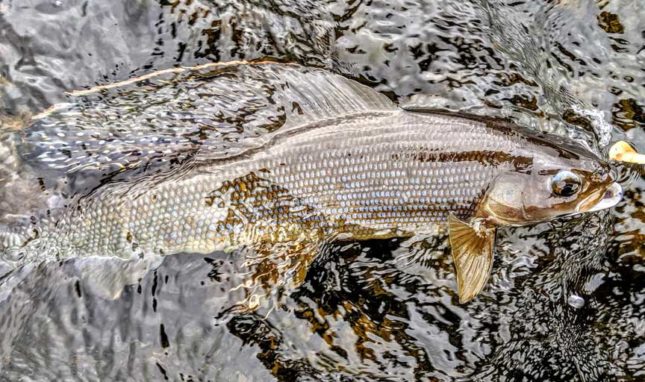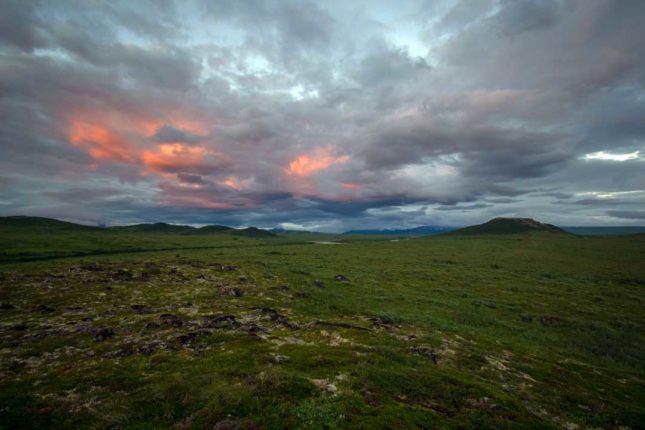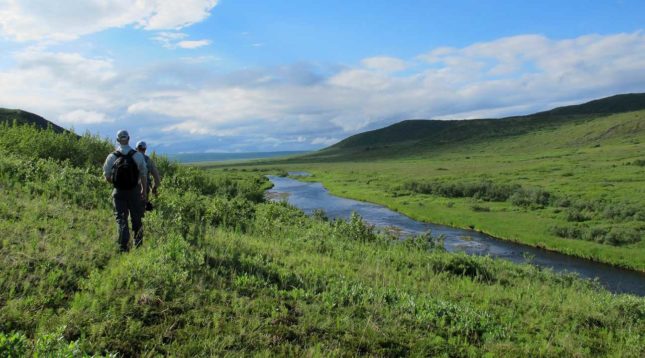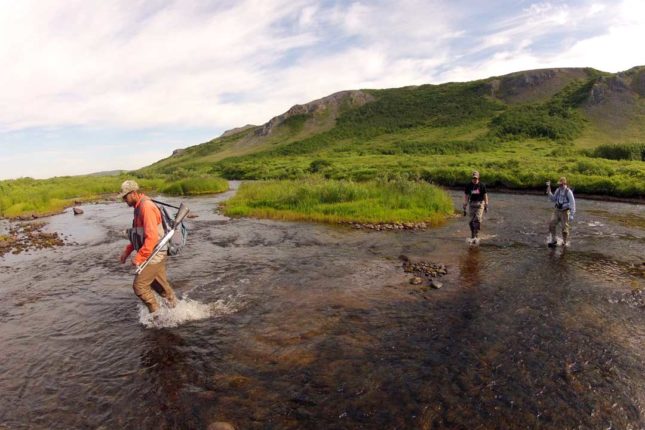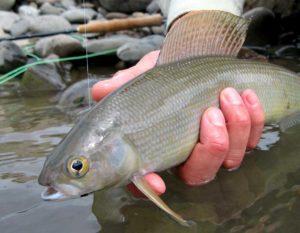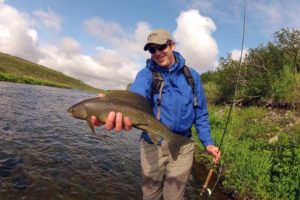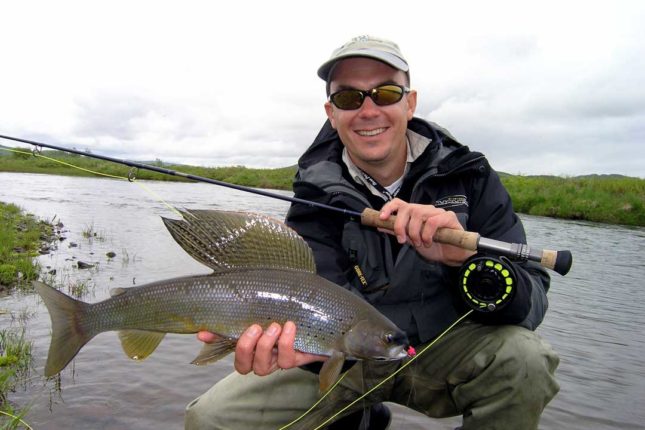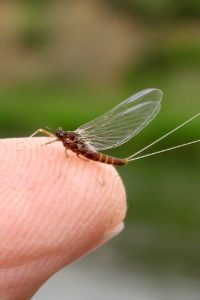Epic Blog
Seven Species Series: Arctic Grayling
07.27.20
Part Three: Arctic Grayling
When most folks sign up to fish with us at our OUTPOST camp, they likely have one of two species of fish in mind: rainbow trout and king salmon. Yes, some anglers want to catch a variety of species, but these are the two names emblazoned in glittering lights up on the marquee. They draw anglers from around the globe. Each with dreams of facing off against the brutal strength of the world’s largest salmon, or basking in the glory of what many consider the best fly fishing for trout on earth.
Every summer thousands of men and women make the annual pilgrimage to one of the most remote regions of the planet, southwest Alaska’s Bristol Bay, in pursuit of fly fishing Nirvana. Yet for all of the tributes and praises that are heaped upon those two aforementioned salmonids, there are unsung tales of another fish, often overlooked. This is one such story.
The March
Early July, 2019. After breakfast ends the procession begins. All four guests clamor out of the large army green cook tent that forms the hearthstone of our camp in eager preparation for another full day of fishing. Even though there’s excellent grayling fishing much closer to camp, today I will lead a group on the arduous hike to the far end of Sleeping Bear, the singular 800 foot high flat topped ridge that rises from the tundra like some slumbering beast. First, we’ll shave a few extra miles off of our journey with a convenient jet boat ride up the turbid river that lies below our camp. We’re dropped off just shy of a tumbling whitehorse rapid that keeps any sane boater from venturing any further.
Now we march. We’re fortunate to have the hard packed terra firma of a game trail for the first leg of the journey. Without it, we would be sentenced to a hard slog through the uneven, spongy surface of open tundra. You don’t go anywhere fast over such ground. Soon we climb a slight ridge and walk along the crest of an enormous alluvial bowl that lays below us. An old river channel from centuries past, now filled in with a patchwork of open marsh, muskegs and thick mazes of willow.
Dark side of the Bear
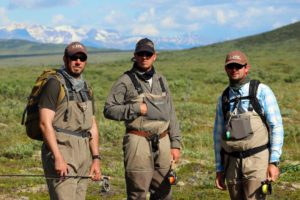
Anglers pause in the tundra. Aleutians in the background. The gentle slop of Sleeping Bear rises to the right.
On a clear day the jagged ridges of the formidable Aleutian Range are visible to the east, towards Katmai National Park, and the Pacific Ocean beyond it. But on this morning the ceiling of matte grey clouds is descending lower and lower, until it feels like we are walking through them as we plod steadily onward, towards our final destination.
The gentle loping foot of Sleeping Bear grows nearer as we are forced to break from the easy going of the game trail. We cut across the open tundra at a sharp diagonal, our target still a ways distant. Now the suns warmth starts to cook off the overcast skies and here and there brilliant rays of light break open upon the still lush landscape. There are fields of Lupin crawling up the flanks of the resting giant, and as we round its base to reconnect with yet another game trail, we silently pass amongst them in single file. At long last we are within view of our creek. It unfurls below us, a glimmering ribbon weaving through the viridescent valley.
We move forward, crossing over to the far side of the ridge. We are out of radio contact from this point on. This is the dark side of the Bear.
Take me to the Islands
We walk between the slumbering giant and the burbling creek. A lone sentinel watches the strange procession from his towering promontory far above; the bald eagle’s profile sits in perfect silhouette against the now bright and open sky. A few well placed field markers guide us as we negotiate our way through columns of Poplar and head high swaths of grass. The silence of the day is broken with the repeated cry of “HO BEAR!, HEY BEAR!, YO BEAR!” You would not want to meet anything that walks on four legs through this stretch, and while it has never happened before, my shotgun always points the way ahead in anticipation of the unexpected.
We break through the last thicket and come into a wide clearing. The sun is on us now, and it is hot. Descending to the creek we stop for a moments rest. This is the customary place to unburden oneself. Packs are dropped. Waders too. Many times a snack is shared. If you’re lucky there’s a slight breeze to whisk the bugs away, if not, you can’t stay for too long. Finally, we have reached the Islands.
Labyrinth of shadows
Imagine a staggered trio of stepping stones on a grand scale. These are the three islands, each covered in thick tufts of grass and blooming with wildflowers. Beyond them, upriver, is the big island. A scimitar shaped cleft of land that hugs close to the northern bank of our creek. A narrow side channel cuts between it and the towering heights of Sleeping Bear. It is here where we will begin our day’s fishing.
We take pause at the head of the big island. Spying over the head high grass that lines its steep banks, we scan the water for signs of life. It doesn’t take long. Just beneath the calm surface, hovering amongst the dark undulating patches of aquatic plants, are Arctic Grayling.
The longer we look, the more of them we see. Some are stationary, given away only by the hypnotic movement of their extravagant dorsals waving in the current. Others push up aggressively through the underwater labyrinth of sunlight and shadows, darting forth sporadically only to retreat and disappear just as quickly. Waiting a moment longer in silent observance a fish rises to the surface. Then another does the same, and another.
We lost count an hour ago
Arctic Grayling might be one of the least discerning fish in the universe of fly fishing. They eat the mouse with the same zeal that they eat the bugger. When we’re mousing for trout under good conditions we will often hook twice as many grayling, especially if we’re using a smaller mouse pattern that allows them to take the hook in their mouth.
It’s rare that we ever set out to exclusively target them. Normally, it’s a mixed bag of trout, dollies, and when the fishing is good, so many grayling that most anglers lose count after the first few hours on the water. Where this fish stands apart from their stream cohorts is in their willingness to rise to a dry fly. It hardly seems to matter if there is an actual hatch going off or not. The only prerequisite is having calm conditions. When the wind howls, which it often does in a landscape mostly devoid of trees, all bets are off.
Odd fellows
Arctic Grayling belong to the Salmonidae family, like trout, salmon and char, yet they are odd fellows when compared to their more common cousins. Most notable is the massive sail-like dorsal that adorns both sexes. On the males this attribute can be as ostentatious as a peacock’s train, a kaleidoscopic display of neon blues and electric oranges set in stark contrast against their dark olive grey skin. Their latin name, Thymallus, is a reference to the common herb, thyme, which their flesh is reported to faintly smell of.
The Arctic Grayling, whose range once extended down into the Great Lakes region (think of Grayling, Michigan) are now mostly relegated to the subarctic and arctic zones of the Northern Hemisphere. They are widespread in Alaska’s freshwater fisheries, but are conspicuously absent from certain regions: notably Kodiak, Southeast, and the Aleutian Island chain. They are long lived fish, averaging 18 years, with some being reported to be as old as 36 years old!
To hand
Back on the big island, standing with our backs to the main channel, we begin. A big Elk Hair Caddis will do nicely. All that is needed is a short cast, a deceptively simple task. We are boxed in. Behind us lies an obstacle course of snag prone branches and grass nearly head high. The footing is bad. The bank is steep and perilous. The sun wants to throw our shadows over the water as it courses across the southern sky, spoiling the element of surprise. But the cast is made, and the blonde fly lands not more than twenty feet distant from where we stand, half crouched amongst the brome and fireweed.
Immediately a single grayling stirs. We watch with held breath as it slides effortlessly through the glades of wavering aquatic plants and rises to the helpless dry. Often, they eat with a subtle slurp, not the hard punch of a trout. Sometimes they porpoise over the fly, missing it entirely, but providing a thrill nonetheless. This time the fly disappears in an instant; the rod comes back straight and hard in the next one. The fish flashes, runs and jumps once. Quick to hand, all three of us step towards the steep bank to have a quick look.
They are firm bodied, sparsely spotted, with large scales running down their flanks. Their tiny oval mouths can make removing a fly a difficult proposition, but we are lucky this time. Underneath each gill there is a single large inky black spot. A disguise, a false pair of eyes perhaps? And even more unique and unusual, their pupil is the shape of teardrop.
Dry fly heaven
We work at a leisurely pace, taking turns between anglers as we go. The fishing is excellent. Each new pocket offers a handful of opportunities as we methodically cover the side channel from top to bottom. It consumes a large part of the day, this short section of skinny water, which would fool many into thinking they were someplace closer to Colorado then the Alaska Peninsula.
This is the epitome of fly fishing distilled down to its finest form. To use light tackle, to fish a dry on the water’s surface, sighting fish, making a precise cast to the one you want and watching as it comes willingly to your fly. It is this above all else that makes fly fishing singular and unique within the pantheon of angling. You could spend days on end doing nothing else, and if it weren’t for the distracting allure of a trout or a Dolly Varden or a salmon you would never want to. But all good things must end, and before long it’s time to depart for a gravel bar happy hour back at camp.
Our shadows stretch out before us in the afternoon light as we retrace our steps from the morning’s walk on the long and winding path back home. In the distance, behind us to the east, we can see the high Aleutians with their saw toothed peaks and snow fields glowing orange with the dipping sun.
Written by Drew Griffith (aka “Machete”). June, 2020
Find more Machete articles here.
Posted in All Posts, Fishing, OUTPOST

